|
As
we drove through the mopane forest an elephant mother and her baby
were blocking the road, so we stopped and waited, watching them
while they ate. Elephants are such amazing creatures, and it was
great to have such a close up view of their thick wrinkled skin,
prehensile trunks and ridiculously long eyelashes. They seem so
intelligent and wise.
When
they finally moved we went around a bend and surprised five or six
more ellies. They were all around us. One big female standing by
the road challenged us, raising her trunk and moving toward us a
bit aggressively. With no room to yield or turn around, Gee gunned
the motor and drove straight at her, contesting for the right of
way.
Fortunately
she backed down, and we were able to accelerate by her safely. Gee
said that if he had hesitated it could have gone badly; she might
have called all the other elephants nearby to come help her squash
us. Playing ‘chicken’ with an elephant is definitely an
exhilarating experience.
A
troop of baboons moved through the forest, backlit by shafts of
golden sunlight stabbing down through the trees. They ambled along
searching for food, stopping now and then to groom each other. A
tiny baby clung upside down to his mother’s belly as she walked.
With their long lithe limbs and athletic way of moving, baboons
really do have a graceful beauty to them – if it wasn’t for
those ugly bald butts!
As we came out of the forest to
more open land, we could see lion tracks in the dusty road. Zebras
grazed and giraffes nibbled at acacia trees. A pair of dainty
steenbok stared up at us as we went by, the male sporting small
sharp horns. Jineen’s count was up to 29 roller birds for the
day. We saw a vehicle license plate lying in the road, and Gee
stopped to pick it up.
We came to the Xakanaxa gate,
entrance to the area where we would be camping. We took a potty
break, and checked out the whiteboard at the gate where wildlife
sightings were recorded - we were intrigued by such entries as Leopard
at Paradise Pools. We forded several water crossings; Gee told
us the water level was lower than usual for the time of year. We
saw many huge termite hills, some of them fifteen feet tall. Three
magnificent kudu bulls stood near the road, their impressive
twisting horns glinting in the sunlight. Kudu-peckers perched on
their necks, picking off insects.
|
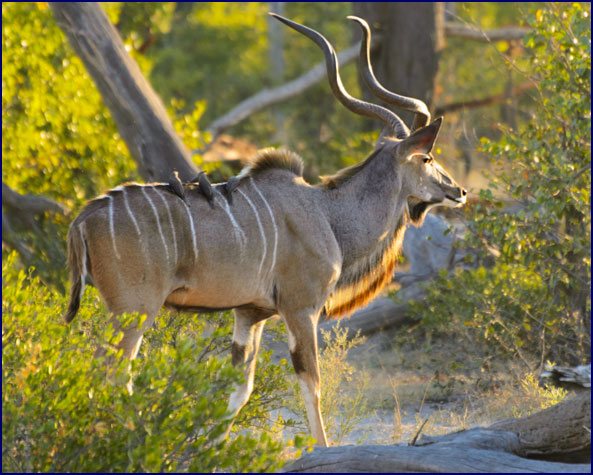
Kudu |
We
arrived at our camp at six o'clock. The area is called Xakanaxa
– try saying that three times real fast! Our familiar tents and
dining table were set in a grove of tall mopane trees. There was
an open area in front of camp; Gee called it the lagoon, but there
was no water in it. He said the floods didn’t reach as far as
usual this year; there had been some water in the lagoon a month
earlier but it was now gone.
It was a beautiful camp, a bit
more spread out than the others. It was also more private –
there were no other camps anywhere nearby. Parrots perched in the
trees and impala wandered along the dry riverbed in the lagoon.
The silvery trunks of dead leadwood trees stood in stark contrast
against the pink sunset sky. It had been another long travel day
for us but longer yet for the staff, who not only made the drive
but built the camp and fixed dinner. Those guys were amazing.
We
sat around the campfire before dinner, watching the stars come out
one by one. The moon, now several days past full, was rising later
each night - so at last we were able to appreciate the
magnificence of the stars in the dark African night sky. We heard
a loud elephant scream just outside camp; peering into the
darkness Gee said he could just barely make out the shapes of two
elephants playfully poking each other with their tusks. Later we
heard them right behind our tent, breaking branches and eating
them.
Gee
told us about an incident where an elephant had come into one of
his camps. A lady was sitting reading a book in an area where he
had told her not to, and when the elephant noticed her it had
turned around and knocked her over in her chair. Gee had
instructed her to sit still and not make a sound; fortunately she
followed his instructions and they were able to distract the
elephant away from her - but it had been a close call.
We asked Gee if there were any
woman guides in Botswana; he replied that there were a few, but
they didn’t last long because they were not tough enough. I
attributed this slightly chauvinistic attitude to the culture in
general, not to Gee personally. After all, he had probably never
worked with horse people, so he wouldn’t know how tough women
can be when necessary!
Gee told us about the local
culture. Wealth in Botswana is counted by how many cows one has.
If a man gets money, he uses it to buy more cows. He might have a
poor house, old clothes and no shoes (people don’t spend their
money on such things), but by golly he has lots of cows, so he is
wealthy.
Botswana weddings last about two
weeks. There may be as many as 600 guests; the whole village
comes, whether they are invited or not, and food and drink is
provided for all. The groom pays a dowry to the bride’s family,
usually 7 cows. At dinner Gee showed us a video of his own
wedding. It was really great to learn about the Botswana way of
life. How different we all are, and yet how much the same. Looking
up at the stars, we deliberated on the universe from diverse
perspectives.
The
stars were astonishing. The Milky Way is brighter in the southern
hemisphere, and with no lights from civilization its hundred
billion stars glittered like diamonds. Scorpius shone brilliant
high overhead, and we could see the kite-shaped Crux, the Southern
Cross, with its two bright pointer stars. Gee pointed out some
unfamiliar southern constellations, such as Corvus the Crow, the
Crane, and the False Cross low on the horizon. And there was
Sagittarius, the teapot, like an old friend in the sky.
Gazing up at the Milky Way, it was
hard to fathom the enormity of it all. How can the universe, with
space and stars and galaxies, go on forever? But if it doesn’t,
how does it end and what is beyond it? It took me back to
childhood memories, when a friend and I would spend hours
contemplating these questions.
August
3
We set out for the morning game
drive at seven. Gee had heard lions calling around five in the
morning and he hoped to find them. It was my turn for the front
seat, and I enjoyed the unobstructed view out the front of the
land cruiser. As we drove among the majestic trees near camp I
marveled at the magical feel of the early African morning.
Here
in the Okavango Delta the scenery was quite different from the
drier lands we had previously been in; it was much more lush and
green, with many areas covered in shallow waters from the floods.
We negotiated a number of water crossings, some quite deep. We saw
fewer big open bodies of water than I had expected, but lots of
marshes and channels. What Gee referred to as islands
seemed more like grassy meadows, but during the flood season they
were surrounded with channels of water.
Seven red-eyed doves perched in a
tree. A herd of red lechwe stood gleaming in the morning sun.
There were lion prints in the road, probably made by those Gee had
heard calling in the wee hours - we followed the tracks hoping to
find them. We passed through a marshy expanse with many large dead
trees; Gee explained that the area had not flooded for many years
while the trees grew, but then the floods shifted and covered the
area with several feet of water, drowning the trees. The roadway
led across a channel deep enough that we had to lift our camera
bags off the vehicle floor to keep them dry – maybe we would
need that snorkel after all!
We
stopped to watch a troop of baboons. It seemed to be a family unit
- the adults groomed one another while the youngsters played.
There were two small babies, held in their mothers’ embrace,
looking like incredibly ugly human infants. But this tranquil
scene was interrupted by the sound of raucous shrieks nearby; a
big male baboon was violently swinging a female around in circles
while she screamed in protest. Then he mated with her, rough and
violent. Gee suggested that the female baboon had probably
misbehaved and the male was punishing her - but to us it seemed
that we were witnessing baboon torture and rape.
|
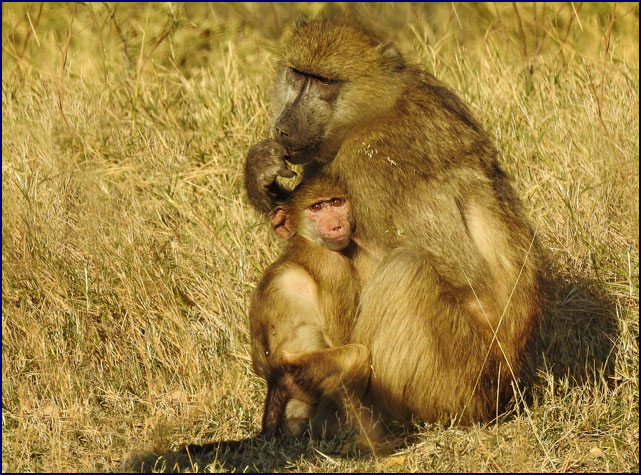
Baboons |
Moving on, we saw
several of the lovely Meyer’s parrots; they are beautiful and
charismatic birds. There were two white storks and a spoonbill
sitting in a tree. We
passed an old hamerkop nest in the crotch of a tree; these sturdy
birds construct huge nests, up to five feet across. They build
with sticks and mud, but will also use any materials they can
find, such as items of clothing, litter, rope, and old flip-flops.
It is said to be very bad luck to rob the nest of a hamerkop.
A white-headed vulture perched on a nest in a treetop,
gazing down at us. Through the binoculars I could see flies
buzzing around its face. These scavengers are huge, with a wing
span of nearly six feet. Seeing the vulture prompted me to share a
little verse I remembered from childhood:
The
Vulture eats between his meals
And that's the reason why
He very, rarely ever feels
As well as you and I.
His eyes are dull, his head is bald,
His neck is getting thinner.
Let this be a lesson to you and I
To only eat at dinner!
~ Hilaire Belloc ~
|
|
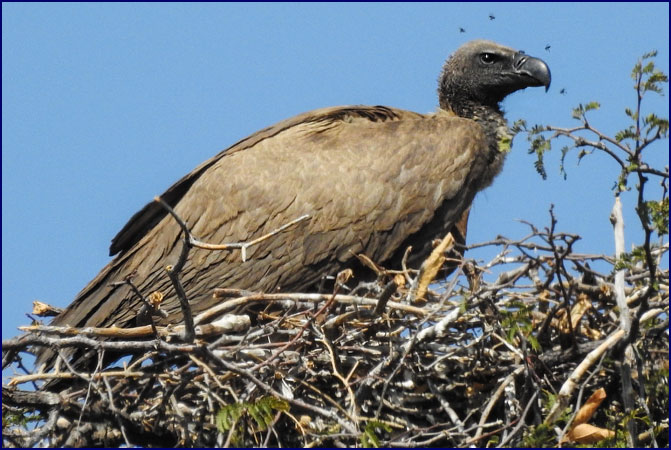
White-headed Vulture
|
We
saw very few other vehicles the whole time we were in the Moremi
Park. Following the lion tracks, we crossed a wide open expanse
punctuated with dead tree trunks, aptly called Dead Tree Island.
We stopped for tea by a flooded lagoon in an area that reminded me
of a putting green, parking next to a huge termite hill. It was
very quiet; just the sound of the birds and the voice of the
occasional hippo. Eighteen elephants walked in a single-file row
along the opposite shore. Hippos moved through the water,
appearing to glide effortlessly but actually walking on the bottom
rather than swimming. Gee explained how termites and hippos are
vital to the delta ecosystem; termite hills often form islands,
and the hippos open up new channels as they make paths through the
marshes.
Gee gave us a lecture about the termite hills. One meter in
height equals ten years of age, so the mound where we had tea
would have been roughly 40 years old. He told us about how
termites farm a mushroom-like fungus inside their hills, which is
what they live on. They have a three month ‘holiday’ in winter
when they go dormant. It was really interesting to learn about the
termite colonies, and how their life cycles are so connected to
the whole ecosystem.
|
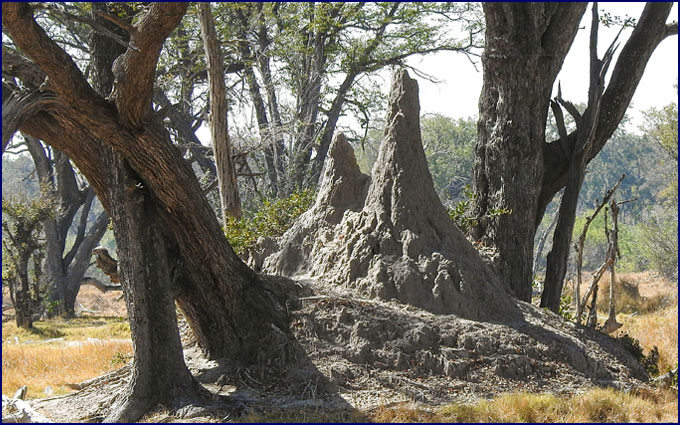
Termite Hill
|
Gee
described growing up on an island in the Okavango Delta, and how
his family would harvest the termites. After a big rain his father
would be able to tell when the termites were ready to fly. He
would dig a big hole nearby and put a sack in it, and then start
fires to attract the termites to the light. They would come out of
the mound in a swarm with a sound like a big wind. When the sack
was full Gee’s father would get another sack to fill, and then
another – for as long as the termites kept coming. The flight of
the termites would attract other things that eat them, such as
giant frogs, pythons, monitor lizards and genets - Gee’s father
would catch those for food also. They would then roast the
termites with a little salt, and then spread them on mats to dry.
Then they would pound them into pulp until they were the
consistency of butter. Gee said this was very good to eat; they
would slice off pieces to serve when they had guests. Friends will
make many excuses to drop by when you have termite butter!
The lion tracks led away from the road to where we could not
follow, but there was much else to see. Driving along the edge of
a large lagoon, there were more hippos in the water and elephants
among the reeds. Several huge crocodiles rested on the banks, and
red lechwe ran through the shallows in long leaping bounds.
On the
bird front, a pair of fish eagles stood on top of an old hamerkop
nest they had taken over and remodeled for their own use. A
striped kingfisher perched on a twig; these small birds eat
insects rather than fish. A hoopoe hopped along the ground looking
for a meal, and we saw a tiny African stone chat in the grass. We
watched a secretary bird as it walked along through the bush and
then took off in flight.
|
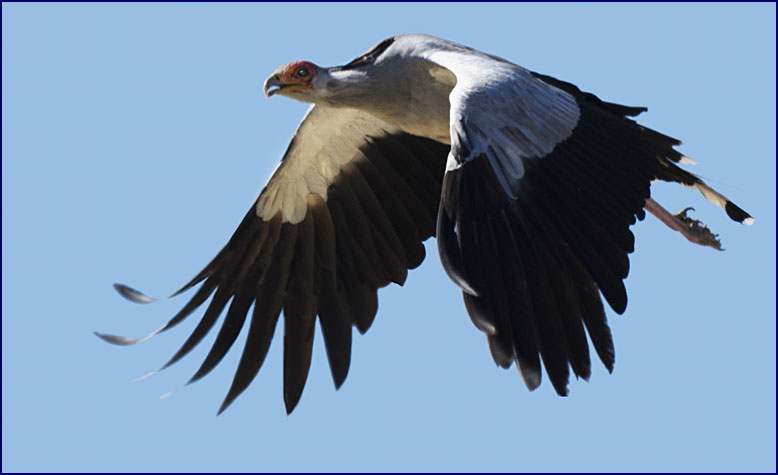
Secretary Bird
|
A
group of vervet monkeys foraged for food, moving along the ground
with an easy grace. Several of them ran effortlessly up a tall
tree and looked down at us impertinently. An impala buck took
offense when several of the monkeys crossed under his belly and
warned them off with a shake of his horns.
Gee pointed out that the dominant
male monkey had an impressive set of bright blue balls. He
explained that the other males have to be very humble and keep
their testicles hidden; if they don’t the dominant male will
castrate them with his teeth. We noticed that the females had two
long wormlike appendages hanging off of their chests, and we
realized these were their nipples. Gee said that monkeys have a
gestation period of 7 ½ months, in contrast to only 3 ½ months
for lions. The biggest threat to the vervet monkeys is hungry
leopards.
|
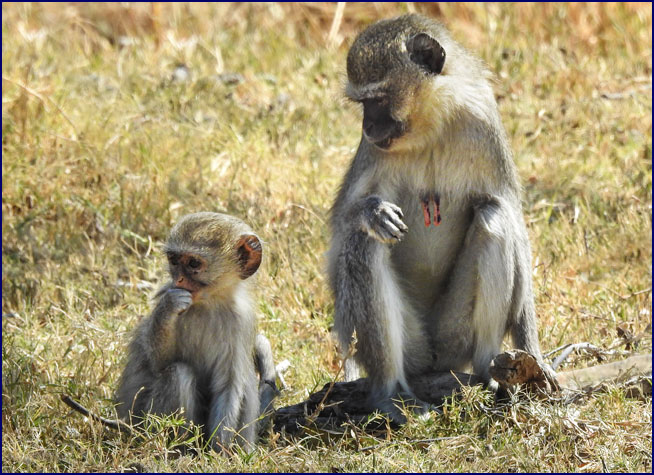
Vervet Monkeys |
We
spent quite a lot of time watching the monkeys, and they did not
seem frightened of us being there. But the odd thing we noticed
was that no matter how close they were to us, they would never
meet our eye. They were definitely aware of our presence, but when
looking toward us they always averted their gaze. This was in
stark contrast to many of the other animals, especially the lions
and leopards, who looked us in the eye boldly as they strolled
past.
We saw more elephants - a breeding
herd passed close to us alongside the road. A mother nursed her
small baby; an elephant’s mammary glands are between her front
legs, and look uncannily humanlike. One of the older babies
challenged us as he came across the road, but his auntie gave a
low rumble to tell him to cut it, and he immediately obeyed.
Teenagers!
Gee
told us that young bulls need elders to train them. He said a Game
Reserve in South Africa took in a group of young rogue elephants
that had been raised as orphans, and they behaved very badly,
trying to mate with the rhinos, and sometimes killing them. The
Reserve brought in a big bull elephant to take charge of the
youngsters, and within a week everything was calm and orderly.
Being in the front seat, I really
enjoyed the chance to talk with Gee while we drove. He told me
about Botswana’s efforts in conservation. He said that the
animal numbers were on the rise; almost all of the species are
increasing due to conservation (with the exception of the rhinos,
which have been illegally hunted to the brink of extinction for
their horns). For the most part the local people now realize that
the animals are worth far more alive bringing in tourist money
rather than being killed for their meat or hides. Botswana has
strong anti-poaching laws, and the Botswana Defense Force is
allowed to shoot poachers on sight.
We arrived back at camp to see
zebras strolling along the dry riverbed near the tents. Open met
us as usual with the tray of drinks; tea in wine glasses, with
sugar-coated rims. When we went in our tents our towels were laid
out on the beds, folded into the shape of an elephant head with a
long trunk. After lunch we took bucket showers and then lounged in
front of the tent, watching and photographing the zebras from the
porch. Hoping to see their stripes reflected in the water, I
decided to add seeing zebras drinking to my wish list.
|
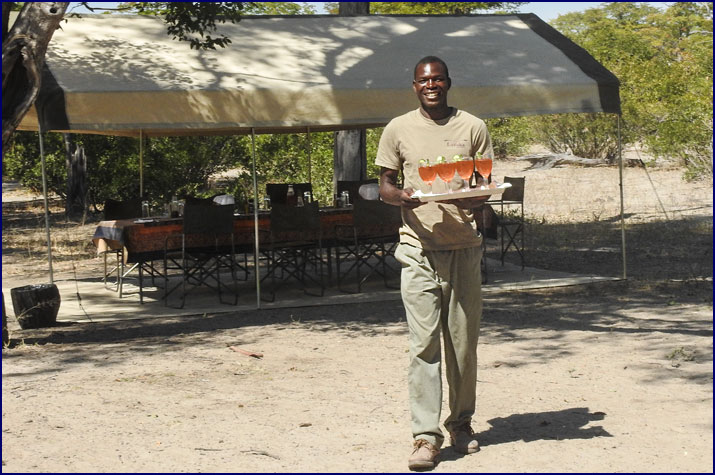
Open
|
In
the afternoon we set out for Jessie’s
Pool. We passed through a forest of dead trees and came to a
long shallow lake. An assortment of storks, herons, ibis and
Egyptian geese lined the shore. Hippos lounged in the water,
chortling at us mirthfully. A red lechwe bull with impressive
twisting horns paraded by us. A very large crocodile lay on the
bank with its mouth held wide open, and several white-faced ducks
stood just inches in front of it - which seemed unwise to us.
We
drove up to the far end of Jessie’s Pool. A lone elephant
approached the water on the far side; she waded in and drank,
sucking up great trunkfulls of water and squirting them into her
mouth. She came straight toward us, moving closer and closer, and
the rest of the herd came up behind her, a dozen or more of them
streaming in to drink. I could sense Gee tensing, ready to back up
and move out of the elephant’s way if she became annoyed – but
he wanted to let her get close if it was safe. She apparently
decided we were OK, and she walked right beside the vehicle. The
rest followed, one by one, moving all around us. One big bull came
so close to the land cruiser that he nearly brushed it, passing
within a meter of where I was sitting in the front seat. It was
fantastic.
Moving on, we forded a deep water channel, almost needing the
snorkel. We passed a mother waterbuck with her baby, and a family
of warthogs. A grey go-away bird was drinking from a pool. We saw
a whole herd of zebras - though not drinking.
We
headed for Paradise Pools, remembering the Xakanaxa gate report of
a leopard sighting there. We drove slowly through stands of tall
elegant mopane trees, searching high limbs for feline forms. It
was an enchanted forest. Long shafts of late afternoon sunlight
bathed the woods in a golden glow. It was like a place where you
would find leopards in your dreams.
An elephant stood in a pool,
spraying water from his trunk. We went on slowly, scanning the
trees for horizontal branches where a leopard might be resting. We
didn’t find one, but it didn’t matter – the hunt is half the
fun. You never know what you are going to find.
The sun was getting low, and the sky
displayed its evening array of pastels. On the way back to camp we
passed the small airstrip. For some reason the road to camp was
blocked off with a road
closed sign, but Gee deftly maneuvered around it through the
bushes. A giraffe stood silhouetted against the pink sky.
We
arrived back at camp just as the sun set, and I got out my tripod
to photograph it. We heard two pearl-spotted owls in the trees at
the edge of camp, calling to each other in ascending whistling
notes. We tried to call them down by imitating their whistles as
Adam had done in Hwange, but apparently we didn't have the
touch.
As darkness fell the Milky Way
shone in all its glory. Around the fire, Nick and I experimented
with photographing the night sky, using a tripod and 30 second
exposures to capture Scorpius, the Southern Cross and the Milky
Way.
|
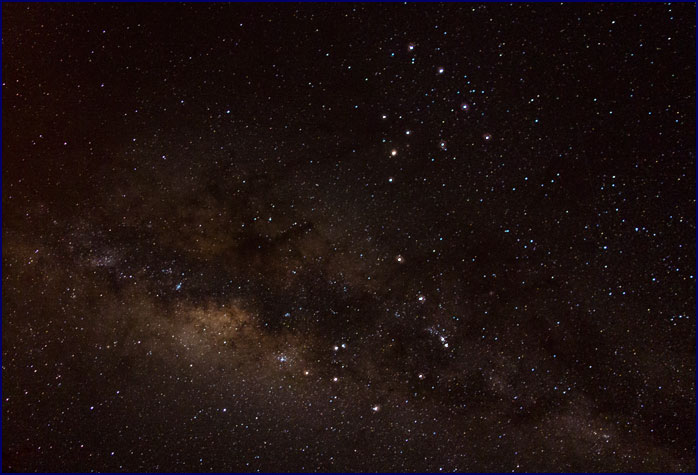
Scorpius
|
After another great dinner, we sat long around the fire
enjoying the celestial display. We talked about our safari
experiences and compared the camps; they had all been excellent
but the consensus was that this last one at Xakanaxa was our
favorite, because it was the most secluded and private. We missed
the sounds of the hippos at Khwai though.
Later we heard lions in the night,
far off at first and then closer. The quiet whoo-oop call of a
hyena just outside camp was like a lullaby. Whenever I think of
Africa, the sounds of the animals in the night is one of my most
abiding memories.
|